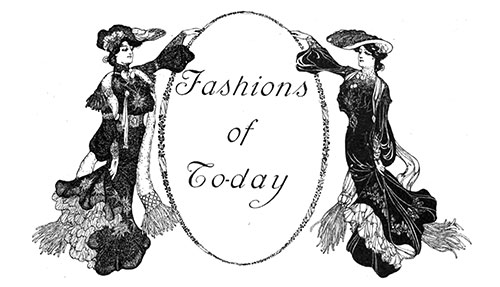Today’s Fashions – December 1903

The sleeve is an important part of the Winter frock, and upon the manner in which it is fashioned the success of a gown largely depends. There was never a time when sleeves showed more diversity, and though certain general lines are imposed, there is infinite variety in detail.
The fulness may begin at the shoulder, or the upper part of the sleeve may be comparatively close fitting and swell into fulness near the elbow. In many instances the effect of a close cap is given by a yoke extending over the top of the sleeve.
Lingerie frills are the most original note of the season's cloth sleeves, lending a dainty touch to a dark wool gown. This little item is one of the many revivals that characterize the season's fashions.
In a charming new bodice fashioned of crepe de Chine and all-over lace, the influence of 1830 is discernible in the deep yoke of lace that comes over the top of the sleeves in cap effect. Small box-plaits add a pleasing touch, as does the softly crushed girdle, and to the slender figure the mode will prove unusually becoming.
There is a growing liking for simple skirts, especially when the material is soft and adapted to flowing lines, and it is in these modes that the woman whose allowance for dress is limited can achieve admirable results.
Groups of tucks, running around the bottom of the skirt, are the only elaboration in some of the smartest modes, while others show folds or bands of broad ribbon.
A pretty effect is attained in a seven-gored skirt that is box-plaited to a rather deep yoke depth and has three folds of contrasting material around the bottom. Silk voile was the fabric used, with soft taffeta for the folds.
Soft taffeta and shot silks, and also the silk and wool materials, offer many possibilities for carrying out the picturesque "1830" designs.
The prevalence of the full skirt, shirrings, flounces, etc., has created a demand for soft, pliable stuffs that will combine lightness of weight with warmth, and even the warm shaggy materials so much in vogue for street wear are astonishingly light and easy to handle.
The success of the new shirt-waist lies in the cut, and the smartest of these, of vesting or heavy mercerized cottons—for the "tub" waist has almost entirely usurped the place once occupied by the flannel and silk affairs—are extremely simple in style, plaits, tucks or an "1830" stole sometimes entering into the scheme.
The epaulette is greatly in evidence upon the new blouse waists and the deep collar, too, is seen. Detached collars and yokes are much used and add a certain distinction to dark blouses. Batiste, embroidered, tucked or with medallions of lace let in, offers pretty suggestions for these accessories, of which there may be a variety of shapes.
Crush girdle belts and fancy stocks are indispensable to the well-appointed wardrobe. Odd bits of silk, satin, lace and ribbon are utilized for these dainty trifles, which any clever woman can readily make.
For loose, flowing coats, that may be in evening full or three-quarter length, the long nap zibelines of softest texture are eminently desirable, and some of the smartest modes show the deep "1830" yoke cape and flowing sleeves. The new velvets are also admirably suited to this garment, while lustrous cloth and silk are also used.
The jaunty little Eton jacket, though somewhat glorified, is as popular as ever, and especially is it liked to accompany a skirt of the same material. Zibeline, cloth, tweed, and other heavy fabrics are selected for these modish two-piece costumes, which will gain dignity by a fur collarette or stole and muff.
The severely tailored costume of covert or heavy cloth or Melton of light weight is made with semi-fitted coat having the dart seams continue to the shoulder. The three-piece skirt, in walking length, is extremely smart and has plaited fulness at the seams.
The many-gored skirt with a decided ripple is perhaps newer for general wear than the plaited mode, and one attractive style is of nine-gored shaping with or without a yoke and has a flat flounce or facing around the bottom.
The quaint "1830” style is reproduced in a five-gored skirt, the distinctive feature of which is the panel straps extending to the lower edge or shaped in points. Sailor suitings in Scotch and English effects, Melton and covert are among the materials best suited to this design.
The changes in kimonos, both long and short styles, are numberless. They are charming in silks of all sorts and plain and figured woolens of soft, pliable quality, with ribbon delicately flowered. The newest idea is the short kimono made of handkerchiefs or squares of silk or wool.
“Fashions of To-day” in The Delineator: An Illustrated Magazine of Literature and Fashion, Paris-London-New York-Toronto: The Butterick Publishing Co., Ltd., Vol. LXII, No. 6, December 1903 p. 901.
Editor's Note: Some terminology used in the description of women's clothing during the 1800s and early 1900s has been changed to reflect more modern terms. For example, a women's "Toilette" -- a form of costume or outfit has an entirely different common meaning in the 21st century. Typical terms applied to "toilette" include outfit, ensemble, or costume, depending on context.

